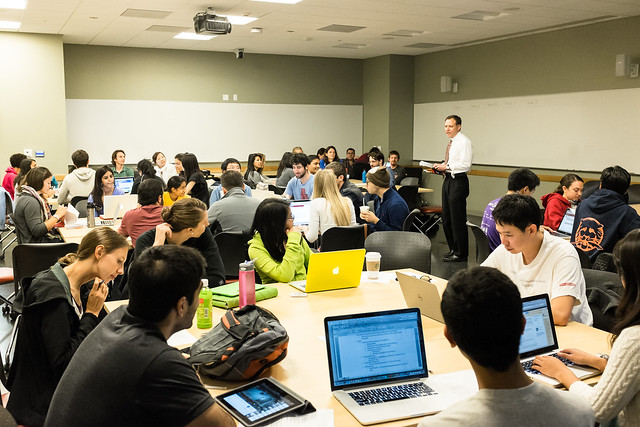 Long ago, a colleague recommended that I address the issue by banning such devices in the classroom. While I understand the reasoning behind this particular suggestion, it left me curious about possible alternatives. My initial brainstorming efforts turned up two options: (1) gear class time towards student engagement so that they aren't tempted to reach for the mobile devices, and/or (2) find a role for them in the classroom. In my classes, students are regularly asking questions about a specific detail or reference a current event that I would need to take a look at before providing a response (a by-product of encouraging students to participate in class and find connections with the material). With laptops and mobile devices, students can play the role of researchers while in the classroom, which is great for offering timely information with the added bonus of engaging students in the process.
Long ago, a colleague recommended that I address the issue by banning such devices in the classroom. While I understand the reasoning behind this particular suggestion, it left me curious about possible alternatives. My initial brainstorming efforts turned up two options: (1) gear class time towards student engagement so that they aren't tempted to reach for the mobile devices, and/or (2) find a role for them in the classroom. In my classes, students are regularly asking questions about a specific detail or reference a current event that I would need to take a look at before providing a response (a by-product of encouraging students to participate in class and find connections with the material). With laptops and mobile devices, students can play the role of researchers while in the classroom, which is great for offering timely information with the added bonus of engaging students in the process. The decision about which approach to take is an individual one and will depend on how the potential benefits stack up against the potential downsides in a given class. "From Distraction to Engagement: Wireless Devices in the Classroom," written by Berlin Fang and published in Educause Quarterly, is an article that outlines both "restrictive" and "integrative" approaches to dealing with laptops and mobile devices in the classroom. The discussion of integrative methods includes some ideas worth considering, including re-mixing class meetings to include more active learning (and less of the passive stuff) and contracting with students to elicit more self-regulation. Responsibility of leading the discussion for the last 10 minutes of class? That would be enough for me to make sure my phone isn't interfering with class!
A shorter article from Jennifer Carey on Edudemic's site, "5 Tips for Classroom Management With Mobile Devices," also highlights student engagement and setting clear expectations for technology use. The "two eyes, two feet" tip is one worth repeating here:
"The biggest shift for educators when technology enters the classroom is that you cannot be static or stable. The best way to ensure that students stay on task is to walk around the room, look at the work they are doing, discuss and engage with them about their progress. The more active and mobile you are in the classroom, the easier it is to ensure that your students are working on what they should be."As for the "Let Them Get the Giggles Out" tip, I was lucky enough to see it in action recently. A member of our team was presenting design tips for digital posters to a class of 70+ students, and after providing a bit of an overview, he asked each group to open the program and encouraged them to use the tips and featured tools to make the tackiest, most outrageous digital poster possible. And they did. After fifteen minutes of shocking color combinations, titles not fit for public viewing, and Tyrannosaurus Rex eating baby penguins, the students moved on to collaborating with their groups on their actual research posters.

